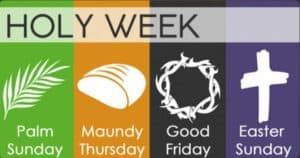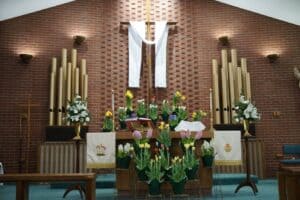Zion Lutheran has had over thirty devoted pastors in its 190 plus years and has served several thousand fellow Lutherans. We are a family, an old and very large family. We continue today as a vibrant parish and continue serving the community by “Serving Christ through Serving Others”
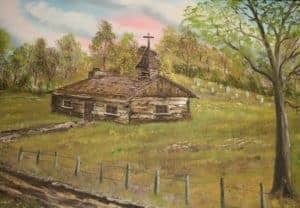
Our first church was a simple structure constructed of logs cut from the building site and the nearby hardwood forest. The floor was planked and rough-hewn benches were installed. The first pastor came as a result of petitioning the New York Synod of the Reformed Church. His name was John Pantz. Pastor Pantz stayed with and nourished our church until 1839. His devoted leadership no doubt is majorly responsible for the survival of our church in its infancy.
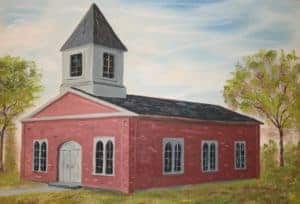 This is the same lot where our present church is located. At that time the lot was on the very western edge of town and still in the woods. It was deeded by John Clark, the town’s founder, to the trustees of the newly named Evangelical Lutheran Church, John Ritter, Jacob Rohrer and John Sanders. John Ritter, a successful farmer, donated two thousand dollars toward the building of the new church. It is reported that the total cost of the structure was slightly over thirty two hundred dollars. The old log Worman Church was abandoned and left to ruin, but the deeded property and cemetery remained in the ownership and care of our church.
The corner stone for the new church was laid on July 16, 1847. This new church was the talk of the county! Brick was used in its construction, and no cost was spared in the quality and beauty of the building.
Upon the death of John Ritter, he bequeathed a lot on the corner of Main and Third Streets and two thousand dollars for the purpose of building a parsonage. The parsonage was built and there it stood until 1920.
Pastor Link moved to Lancaster, Ohio in 1848 but Pastor Link returned as our Pastor in June 1861. He served here until his death on March 30, 1862.
Sometime during the period of 1847 and 1850, our church began to be known as the English Lutheran Church.
After Pastor Link’s no new pastor was called until late in 1863. Preoccupation with the Civil War and the terrible carnage war was brought home to Tippecanoe by our soldiers returning maimed. Many families were mourning the deaths of their young men. Then came Pastor Solomon Weills. Under his leadership the church experienced a new birth, and it was found then, as now, great comfort and solace can be found in the walls of our church.
This is the same lot where our present church is located. At that time the lot was on the very western edge of town and still in the woods. It was deeded by John Clark, the town’s founder, to the trustees of the newly named Evangelical Lutheran Church, John Ritter, Jacob Rohrer and John Sanders. John Ritter, a successful farmer, donated two thousand dollars toward the building of the new church. It is reported that the total cost of the structure was slightly over thirty two hundred dollars. The old log Worman Church was abandoned and left to ruin, but the deeded property and cemetery remained in the ownership and care of our church.
The corner stone for the new church was laid on July 16, 1847. This new church was the talk of the county! Brick was used in its construction, and no cost was spared in the quality and beauty of the building.
Upon the death of John Ritter, he bequeathed a lot on the corner of Main and Third Streets and two thousand dollars for the purpose of building a parsonage. The parsonage was built and there it stood until 1920.
Pastor Link moved to Lancaster, Ohio in 1848 but Pastor Link returned as our Pastor in June 1861. He served here until his death on March 30, 1862.
Sometime during the period of 1847 and 1850, our church began to be known as the English Lutheran Church.
After Pastor Link’s no new pastor was called until late in 1863. Preoccupation with the Civil War and the terrible carnage war was brought home to Tippecanoe by our soldiers returning maimed. Many families were mourning the deaths of their young men. Then came Pastor Solomon Weills. Under his leadership the church experienced a new birth, and it was found then, as now, great comfort and solace can be found in the walls of our church.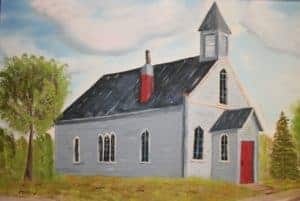 On May 5, 1895, the new church building was dedicated. It was a short time after this that the name of the church was changed from the English Lutheran Church to Zion Evangelical Lutheran Church. The capstone over the entrance to our church still reflects the “English Church” name as it was originally installed when the building was constructed.
T.C. Leonard and family, on Easter Sunday, 1895 gave the bell currently ringing in our belfry to the church.
During 1906 the church was remodeled to include the upstairs Sunday school rooms. This same year our church, under the direction of Pastor W.F. Rangeler, was instrumental in establishing the Feghtly Home for Women. Also 1906 saw the establishment of a Sunday School Library loaning books to children of the community for many years. All the books were eventually given to the local Public Library when it was established.
In 1916, a vacant lot on the northwest corner of Third and Main was purchased from the heirs of the John Kantz estate for five thousand dollars. The clearing away of the Kantz home opened the corner to an unobstructed view of the church, and afforded the opportunity for landscaping and the installation of our church sign.
The parsonage built in 1862, on the southwest corner of Third and Main Streets was moved in 1920, to a location on Third Street adjacent to the church.
On May 5, 1895, the new church building was dedicated. It was a short time after this that the name of the church was changed from the English Lutheran Church to Zion Evangelical Lutheran Church. The capstone over the entrance to our church still reflects the “English Church” name as it was originally installed when the building was constructed.
T.C. Leonard and family, on Easter Sunday, 1895 gave the bell currently ringing in our belfry to the church.
During 1906 the church was remodeled to include the upstairs Sunday school rooms. This same year our church, under the direction of Pastor W.F. Rangeler, was instrumental in establishing the Feghtly Home for Women. Also 1906 saw the establishment of a Sunday School Library loaning books to children of the community for many years. All the books were eventually given to the local Public Library when it was established.
In 1916, a vacant lot on the northwest corner of Third and Main was purchased from the heirs of the John Kantz estate for five thousand dollars. The clearing away of the Kantz home opened the corner to an unobstructed view of the church, and afforded the opportunity for landscaping and the installation of our church sign.
The parsonage built in 1862, on the southwest corner of Third and Main Streets was moved in 1920, to a location on Third Street adjacent to the church.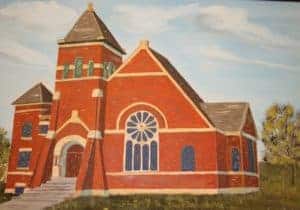
On All Saints Day of November 1, 1964, a rededication service was held in a new modernized sanctuary completed with new pews, altar, choir loft, and a modern Allen electronic organ. The sanctuary of today remains much as it was on the day of rededication.
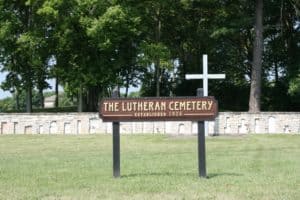 and bring
it into the province of our congregation. In 1978, a large stainless steel cross was installed thus permanently marking the location of the little log church where our history began. In 1990 a stone wall, eighty-five feet long, was constructed behind the cross. Many of the broken and vandalized head stones were incorporated in the wall as a means of preserving them. The precious place of our beginnings is now and forever rightfully back in the mainstream of our church.
and bring
it into the province of our congregation. In 1978, a large stainless steel cross was installed thus permanently marking the location of the little log church where our history began. In 1990 a stone wall, eighty-five feet long, was constructed behind the cross. Many of the broken and vandalized head stones were incorporated in the wall as a means of preserving them. The precious place of our beginnings is now and forever rightfully back in the mainstream of our church. History compiled from Church records by W. C. Posey
History updated in 2018 by Marianne Barnhart
Photos of previous buildings were painted by W. C. Posey
